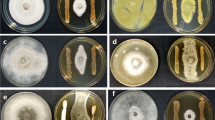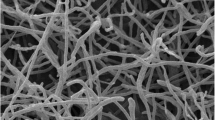Abstract
Phytopathogenic fungi would induce a variety of plant diseases, resulting in a severe reduction of agricultural output. However, the current plant disease control is mainly dependent on the environmentally and healthily hazardous chemical fungicides. Thus, the present work aimed to isolate an effective antagonistic microorganism against various soilborne phytopathogenic fungi. By dual culture with Rhizoctonia solani, a novel Streptomyces specie, Streptomyces sp. N2, was screened out from a total of 167 isolated actinomycetes, which displayed a strong inhibitory effect on R. solani (26.85 ± 1.35 mm of inhibition zone diameter). By means of macroporous resin and silica gel column chromatography coupled with preparative HPLC, an antifungal metabolite (3-methyl-3,5-amino-4-vinyl-2-pyrone, C6H7O2N) was isolated and purified from Streptomyces sp. N2. The bioassay results showed that the purified antifungal metabolite could not only possess a broad-spectrum inhibitory effect on a range of plant pathogenic fungi in vitro (e.g., R. solani, Pyricularia grisea, Fusarium oxysporum f. sp. niveum, F. oxysporum f. sp. vasinfectum, Penicillium italicum, and Colletotrichum gloeosporioides), but also had a significantly effective in vivo biocontrol efficacy on grape fruits anthracnose caused by C. gloeosporioides. Microscopic observation indicated that the antifungal metabolite from Streptomyces sp. N2 would exert its antimicrobial activity by disorganizing the cytoplasmic organelles of phytopathogenic fungi. The above results suggested that Streptomyces sp. N2 was one of promising fungicide for biocontrol of fungal plant diseases, especially due to its broad-spectrum and effective antagonist on various plant pathogens.







Similar content being viewed by others
References
Raaijmakers, J. M., Paulitz, T. C., Steinberg, C., Alabouvette, C., & Moënne-Loccoz, Y. (2009). The rhizosphere: a playground and battlefield for soilborne pathogens and beneficial microorganisms. Plant and Soil, 321, 341–361.
Berendsen, R. L., Pieterse, C. M., & Bakker, P. A. H. M. (2012). The rhizosphere microbiome and plant health. Trends in Plant Science, 17, 478–486.
Doornbos, R. F., van Loon, L. C., & Bakker, P. A. H. M. (2012). Impact of root exudates and plant defense signaling on bacterial communities in the rhizosphere. A review. Agronomy for Sustainable Development, 32, 227–243.
Chakraborty, S., & Newton, A. C. (2011). Climate change, plant diseases and food security: an overreview. Plant Pathology, 60, 2–14.
Kim, H. J., Lee, E. J., Park, S. H., Lee, H. S., & Chung, N. (2014). Biological control of anthracnose (Colletotrichum gloeosporioides) in pepper and cherry tomato by Streptomyces sp. A1022. The Journal of Agricultural Science, 6, 54–62.
Weller, D. M., Raaijmakers, J. M., Gardener, B. B. M., & Thomashow, L. S. (2002). Microbial populations responsible for specific soil suppressiveness to plant pathogens 1. Annual Review of Phytopathology, 40, 309–348.
Spadaro, D., & Gullino, M. L. (2005). Improving the efficacy of biocontrol agents against soilborne pathogens. Crop Protection, 24, 601–613.
Palaniyandi, S. A., Yang, S. H., Zhang, L., & Suh, J. W. (2013). Effects of actinobacteria on plant disease suppression and growth promotion. Applied Microbiology and Biotechnology, 97, 9621–9636.
Boukaew, S., Chuenchit, S., & Petcharat, V. (2011). Evaluation of Streptomyces spp. for biological control of Sclerotium root and stem rot and Ralstonia wilt of chili pepper. Biocontrol, 56, 365–374.
Xiong, Z. Q., Tu, X. R., Wei, S. J., Huang, L., Li, X. H., Lu, H., & Tu, G. Q. (2013). In vitro antifungal activity of antifungalmycin 702, a new polyene macrolide antibiotic, against the rice blast fungus Magnaporthe grisea. Biotechnology Letters, 35, 1475–1479.
Harikrishnan, H., Shanmugaiah, V., Balasubramanian, N., Sharma, M. P., & Kotchoni, S. O. (2014). Antagonistic potential of native strain Streptomyces aurantiogriseus VSMGT1014 against sheath blight of rice disease. World Journal of Microbiology and Biotechnology, 30, 3149–3161.
Summerell, B. A., Laurence, M. H., Liew, E. C., & Leslie, J. F. (2010). Biogeography and phylogeography of Fusarium: a review. Fungal Diversity, 44, 3–13.
Zhao, S., Liu, D. Y., Ling, N., Chen, F. D., Fang, W. M., & Shen, Q. R. (2014). Bio-organic fertilizer application significantly reduces the Fusarium oxysporum population and alters the composition of fungi communities of watermelon Fusarium wilt rhizosphere soil. Biology Fertility of Soils, 50, 765–774.
Li, C. H., Zhao, M. W., Tang, C. M., & Li, S. P. (2010). Population dynamics and identification of endophytic bacteria antagonistic toward plant-pathogenic fungi in cotton root. Microbial Ecology, 59, 344–356.
Araújo, L., Gonçalves, A. E., & Stadnik, M. J. (2014). Ulvan effect on conidial germination and appressoria formation of Colletotrichum gloeosporioides. Phytoparasitica, 42, 631–640.
Liu, P., Cheng, Y. J., Yang, M., Liu, Y. J., Chen, K., Long, C. A., & Deng, X. X. (2014). Mechanisms of action for 2-phenylethanol isolated from Kloeckera apiculata in control of Penicillium molds of citrus fruits. BMC Microbiology, 14, 242.
Strange, R. N., & Scott, P. R. (2005). Plant disease: a threat to global food security. Annual Review of Phytopathology, 43, 83–116.
Couillerot, O., Loqman, S., Toribio, A., Hubert, J., Gandner, L., Nuzillard, J. M., Ouhdoucha, Y., Clémentc, C., Barkac, E. A., & Renault, J. H. (2014). Purification of antibiotics from the biocontrol agent Streptomyces anulatus S37 by centrifugal partition chromatography. Journal of Chromatography B, 944, 30–34.
Kim, B. S., & Hwang, B. K. (2007). Microbial fungicides in the control of plant diseases. Journal of Phytopathology, 155, 641–653.
Acknowledgments
This work was financially supported by the Training Program for Young Scientists of Jiangxi Provincial Department of Science and Technology (20142BCB23025), International Scientific and Technological Cooperation Projects of Jiangxi Provincial Department of Science and Technology (20141BDH80033), and Jiangxi Undergraduate Training Programs for Innovation and Entrepreneurship (201410410008).
Compliance with Ethical Standards
ᅟ
Conflict of Interest
The authors declare that they have no conflict of interest. This article does not contain any studies with human participants or animals performed by any of the authors.
Author information
Authors and Affiliations
Corresponding author
Rights and permissions
About this article
Cite this article
Xu, B., Chen, W., Wu, Zm. et al. A Novel and Effective Streptomyces sp. N2 Against Various Phytopathogenic Fungi. Appl Biochem Biotechnol 177, 1338–1347 (2015). https://doi.org/10.1007/s12010-015-1818-5
Received:
Accepted:
Published:
Issue Date:
DOI: https://doi.org/10.1007/s12010-015-1818-5




